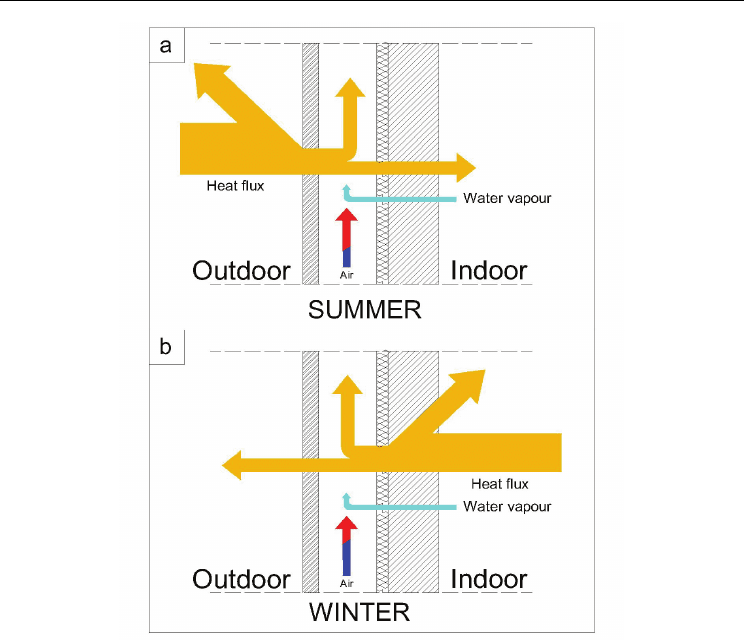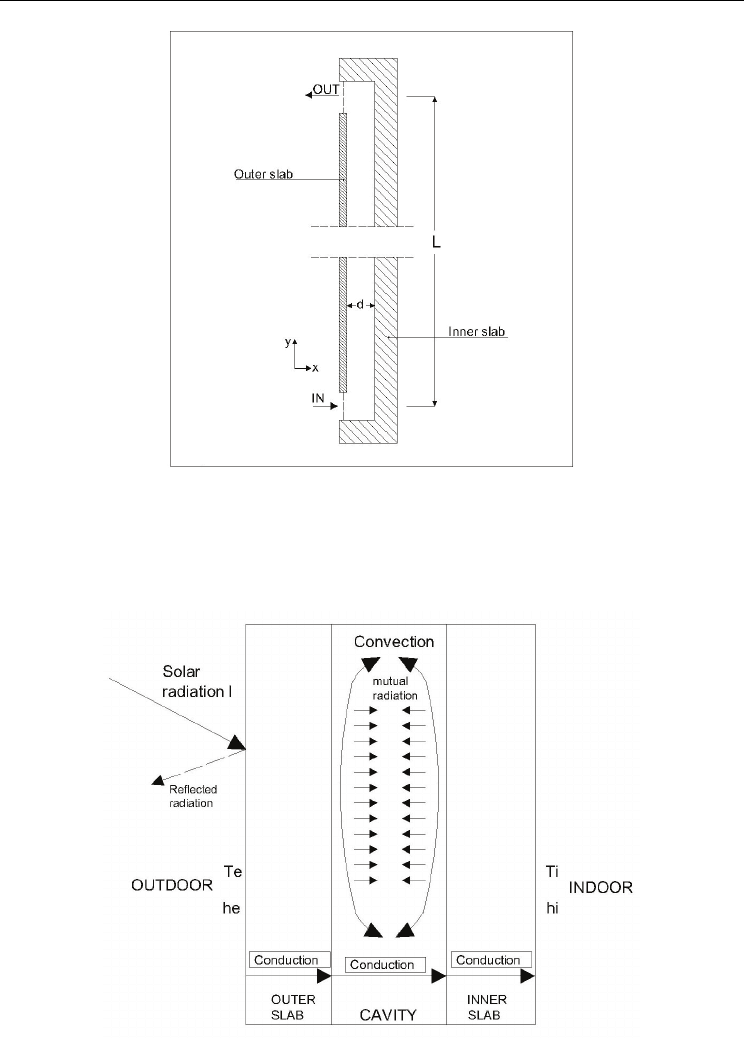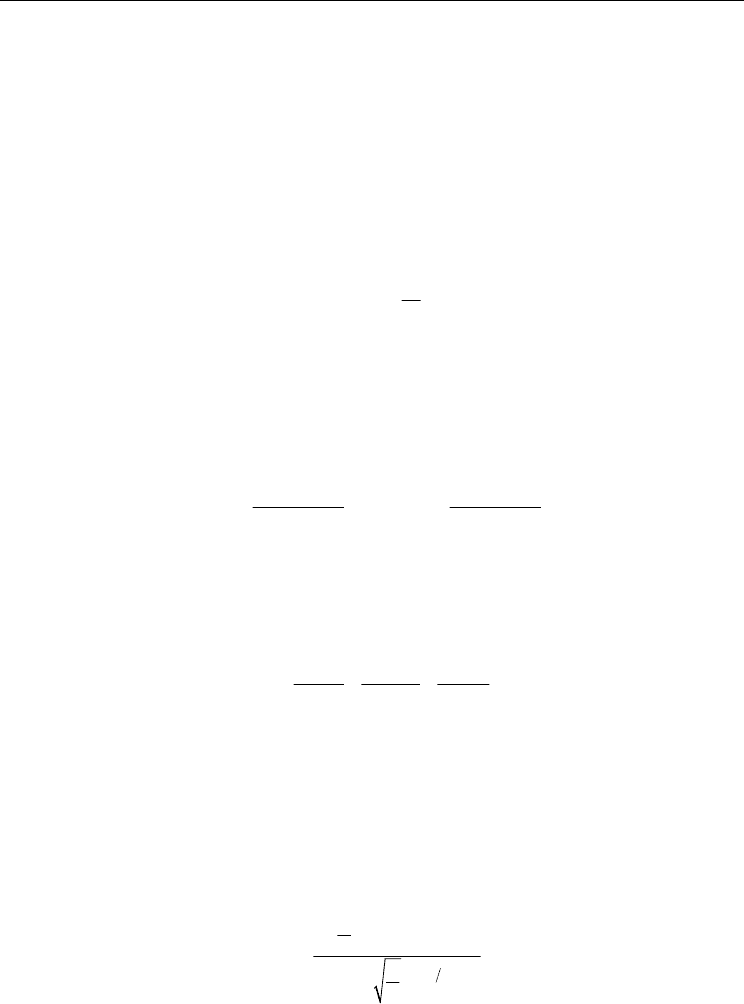Ahsan A. (ed.) Evaporation, Condensation and Heat transfer
Подождите немного. Документ загружается.

17
Computational Fluid Dynamic Simulations of
Natural Convection in Ventilated Facades
A. Gagliano, F. Patania, A. Ferlito, F. Nocera and A. Galesi
Department of Industrial and Mechanics Engineering, Faculty of Engineering,
University of Catania,
Italy
1. Introduction
The European Directive 2002/91/EC (Energy Performance of Buildings) aims to achieve
minimum standards on the energy performance of new buildings and existing buildings
that are subject to major renovation.
To evaluate the energy performance of a building is necessary to calculate the energy
required to satisfy the various services related to the standard usage of the building.
In order to achieve the minimum standards for energy certification should be an approach
to design alternative to the traditional one which allows to reduce significantly the
building's energy requirements maintaining the level of indoor comfort.
The energy needs of the building depend on the efficiency of envelope: when it was not
designed and constructed correctly, the heat fluxes through the structures (vertical,
horizontal, transparent, opaque) cause a large increase in final energy consumption.
The heat exchanges depend on the temperature difference between the inner and the outer
faces of the boundary element (horizontal or vertical) and the thermal resistance of the
material (or combination of materials) that constitute the envelope and the contribute of
solar radiation.
In summer, especially during the days with high values of temperature and solar radiation,
the building envelope should be designed and constructed so as to ensure adequate
environmental conditions for thermal comfort in the indoor environment, even in absence of
conditioning systems.
2. The ventilated facade system
The ventilated facade is a multi-layer coating system that was born in Northern Europe in
order to have an envelope that combine aesthetic aspect with a strong positive valence
valuable in terms of insulation and energy saving.
Subsequently the deep technological innovations have improved the system and it has
found large use in many other countries with increasing recognition.
Today the use of ventilated structures in new buildings is a widely used solution in
architecture because it provides both high energy savings and elevated aesthetic - formal
contents.

Evaporation, Condensation and Heat Transfer
350
Contemporary architecture shows an increased interest in the building envelope, such as
evidenced by the words of Herzog: "It is meaningful to talk about of the building envelope as a"
skin "and not merely a "protection", something that "breathes", which governs the weather and
environmental conditions between the inside and outside, similar to that of humans. "
Among the examples of structures that use the system of the ventilated facade is possible to
cite the Jewish Museum in Berlin of Libeskind, the Gehry's Guggenheim Museum in Bilbao
and the Theatre La Scala in Milan built by Botta.
The use of ventilated walls and roof is also a useful application in case of restoration and
renovation of old buildings. There is a significant number of legislative measures to promote
increases in volume when they produce an improvement in the energy behavior of the
building.
From a structural viewpoint, a ventilated facade presents an outer facing attached to the
outer wall of the building through a structure of vertical and horizontal aluminum alloy or
other high-tech materials, so as to leave between the outer and inner wall surfaces a "blade"
of air. Often the gap is partially occupied by a layer of insulating material attached to the
wall of the building, to form a "coat" protected from atmospheric agents by the presence of
the external face of the ventilated facade.
Each of the layers that make up the ventilated wall has a very specific function (see fig.1):
1. The outer coating is designed to protect the building structure from atmospheric
agents, as well as being the finishing element that confers the building aesthetic
character. Among the coating systems can be distinguished those made of "traditional
materials" and those made using "innovative materials "(metal alloys or plastics).
Recently found increasing use materials already widely used in traditional as ceramic
or brick, produced and implemented in a completely innovative way, such as
assembly of prefabricated modular panels attached by mechanical means without
recourse traditional mortars. This application has many advantages such as ease of
installation and maintenance, both favored by the possibility of intervention on each
slab.
2. The resistant layer, which can either be made of load-bearing walls (made of bricks,
blocks of lightweight concrete or brick) or traditional masonry (brick or stone, mixed) to
be recovered and been rebuilt, is that to which is secured by an anchoring system
properly sized, the outer coating.
3. The insulating layer has the task to cancel the thermal bridges, forming an effective
barrier to heat loss. The uneven distribution of surface temperatures, especially in
modern building which is in fact discontinuous in shape and heterogeneity of materials,
determines areas of concentration of heat flux. This problem is drastically reduced by
the system of insulation coat, which surrounds the building with a cover of uniform
thermal resistance with significant energy benefits.
4. The anchoring structure (substructure), usually made of aluminum alloy is directly
anchored to the inner wall using special anchors. Since its function is to support the
weight of the external coating, the choice of the kind of structure and the sizing must
take into account such factors as the weight of the coating, the characteristics of the
surrounding environment and the climate of the area (wind, rain, etc.).
5. The air gap between the resistant element and the coating is the layer within which
generates an upward movement of air, the chimney effect, triggered by heating of the
external coating.

Computational Fluid Dynamic Simulations of Natural Convection in Ventilated Facades
351
Fig. 1. Ventilated facade - Section
From a thermo-fluid dynamic viewpoint , during summer period, the outside air entering in
the cavity, is heated by contact with the external face at a higher temperature due to the
incident solar radiation. This causes a change in air density inside the air gap and the
formation of an upward movement that produces a benefit especially in the summer (see
fig.2 a) because it eliminates some of the heat that is not reflected by coating.
During the winter season (see fig.2 b) the solar radiation incident on the structure is much
smaller than in summer and the air outside and inside the gap have approximately the same
temperature, resulting in a very reduced stack effect. The movement of air allows the
evacuation of water vapor decreasing the possibility of interstitial condensation.
The study of the energy performance of ventilated walls requires a CFD analysis of the
airflow within the cavity both in cases where it is due only to thermal and pressure
gradients (chimney effect), and when it is induced by the propulsion of fans (forced
convection).
This thermo-fluid dynamics analysis of the ventilated cavity is a very complex procedure,
which requires a very detailed knowledge of the geometry of the system and thermo
physical properties of materials.
These elements, in addition to the difficulties in the determination of the convective
coefficients the approximations necessary for the values used for the boundary conditions
can drastically reduce the reliability of CFD methods based on numerical solution of this
problem.

Evaporation, Condensation and Heat Transfer
352
Fig. 2. Summer (a) and winter (b) functioning of ventilated facade
3. The calculation model
Authors have developed a calculation model to evaluate the energy performances of the
ventilated façade. The first critical step of the numerical solution of a thermo-fluid dynamics
problem is the identification of an appropriate physical model able to describe the real
problem.
The best choice is to use a physical model not excessively complex.
Therefore have been made two very important choices:
- The use of a two-dimensional geometric model;
- The introduction of the hypothesis of stationarity.
The ventilated walls object of the study have been schematized as a two-dimensional system
(see fig.3) consisting of two slabs, one internal and one external, which delimit a duct in
which the air flows. The structure has length “L” and thickness of the air gap “d”. The
Cartesian reference system has been placed with the origin at the beginning of the
ventilation duct, oriented with the y-axis in the direction of motion.
At the base and upper part of the facade there are two air vents, with height “a”, which
connect the ventilated cavity with the external environment.

Computational Fluid Dynamic Simulations of Natural Convection in Ventilated Facades
353
Fig. 3. Bi-dimensional model of ventilated facade
The second critical step in the numerical resolution of the problem is the characterization of
the heat exchanges.
The ventilated structure is characterized by the simultaneous presence of three types of heat
transfer: convection, conduction and radiation (see fig. 4).
Fig. 4. Heat exchanges

Evaporation, Condensation and Heat Transfer
354
The transmission of heat will be caused by:
- convective and radiative exchanges between the external environment and the exterior
surface of the coating;
- conductive heat exchange through the walls of the duct;
- radiative exchange between the two slabs delimiting the air gap;
- convective heat exchange between these slabs and the air circulating inside the channel;
- convective and radiative exchanges between the indoor and the intrados of the inner
wall.
The conductive heat transfer through the inner and outer walls has been characterized by
the conductive thermal resistance defined by:
i
cond
i
i
s
R
λ
=
∑
(1)
where s
i
and λ
i
and are respectively the thickness and thermal conductivity of the i-th layer
of the wall.
In steady-state analysis, the convective and the radiative heat transfers within the ventilated
cavity can be represented with an acceptable level of accuracy considering two thermal
resistances, r
1
and r
2
, expressed by the following equations :
0
1
0
A
AB
R
rr
rrR
=
++
and
0
2
0
B
AB
R
rr
rrR
=
++
(2)
where r
A
and r
B
are the thermal resistances due to the convective exchange between the fluid
and the two garments (A and B respectively), while the thermal resistance R
0
characterizes
the mutual radiative exchange between the two inner sides of the ventilated duct.
The thermal resistance R
0
has been expressed by the following equation:
12
0
11 112 22
111ee
R
Ae AF Ae
−−
=+ +
⋅⋅ ⋅
(3)
where A
1
and A
2
are the areas of the two slabs, F
12
is the view factor between the two
parallel surfaces, while e
1
and e
2
are the emissivity coefficient on both sides of the duct.
The convective thermal resistance (r
A
and r
B
) inside the ventilated channel have been
assessed using the relationship of Gnielinski valid for Reynolds numbers (Re) higher than
2300.
Using this model it is possible to calculate the Nusselt number of fluids in transient
conditions from linear to turbulent flow which can be expressed as:
()
()
0
23
Re 1000 Pr
8
1 12.7 Pr 1
8
Nu
ξ
ξ
−
=
+−
(4)
Where Pr is the Prandtl number and ξ represents the friction coefficient, calculated by means
of the correlation discovered by Petukhov reported below:

Computational Fluid Dynamic Simulations of Natural Convection in Ventilated Facades
355
()
2
1
1.82lo
g
Re 1.64
ξ
=
−
(5)
The influence of temperature has been considered with the introduction of the following
relation:
0.36
0
m
w
T
Nu Nu
T
⎛⎞
=
⎜⎟
⎜⎟
⎝⎠
(6)
where
T
m
is the mean temperature of the fluid in the cavity and T
w
is the temperature of the
wall of the ventilated duct.
The convective thermal resistances (
r
A
and r
B
) at inner and outer surfaces of the duct have
been calculated by the equations:
0.36
0
m
Au
wA h
T
rN
TD
λ
⎛⎞
=
⎜⎟
⎜⎟
⎝⎠
and
0.36
0
m
Bu
wB h
T
rN
TD
λ
⎛⎞
=
⎜⎟
⎜⎟
⎝⎠
(7)
where
D
h
is the hydraulic diameter defined as:
()
2
h
dL
D
dL
=
+
(8)
The third step of the numerical solution of the problem is the definition of energy and
motions equations for the flow of the air inside a cavity.
The steady state energy balance has been applied to a control volume, which represents the
whole of modules with two opaque layers separated by the air channel.
The time–averaged Navier-Stokes equations of motion for steady, compressible flow can be
written as :
-
Conservation of mass (continuity) in i
th
direction
()
0v
t
ρ
∂
+∇⋅ =
∂
G
(9)
Where ρ is the air density and v
G
the velocity vector
-
Conservation of momentum in i
th
direction
() ( )
()vvvp gF
t
ρρ τρ
∂
+∇ =−∇ +∇ + +
∂
G
G
GG G
(10)
where p is the static pressure,
τ
is the shear stress tensor, while g
ρ
G
and F
G
represent
respectively the body and the external forces.
-
Conservation of energy
()
(
)
()
e
ff
ii e
ff
h
i
EvEp kThj vS
t
ρρ τ
⎡⎤
∂
+∇⋅ + =∇⋅ ∇ − + ⋅ +
⎡⎤
⎢⎥
⎣⎦
∂
⎢⎥
⎣⎦
∑
G
GG
G
(11)
where
k
eff
is the effective conductivity.

Evaporation, Condensation and Heat Transfer
356
The first three terms in the right side of the equation represent energy exchanges due to
convection, conduction and viscous dissipation, while the term
S
h
includes the contributions
of the heat produced by chemical reactions.
The two transport equations for the standard
k-epsilon model, also derived from the Navier-
Stokes equations, can be written as follows:
-
Turbulent kinetic energy (k-equation)
()
()
t
ikbMk
ijkj
k
kku PPYS
tx x x
μ
ρρ μ ρε
σ
⎡⎤
⎛⎞
∂∂ ∂ ∂
⎢⎥
+=+++−−+
⎜⎟
⎜⎟
∂∂ ∂
⎢⎥
⎝⎠
⎣
⎦
(12)
-
Kinetic energy of turbulence dissipation (ε-equation)
()
() ()
2
132
t
ikb
ijkj
uCPCPCS
tx x xk k
εεεε
μ
εε ε
ρε ρε μ ρ
σ
⎡⎤
⎛⎞
∂∂ ∂ ∂
⎢⎥
+=+++−+
⎜⎟
⎜⎟
∂∂ ∂
⎢⎥
⎝⎠
⎣
⎦
(13)
Where the turbulent viscosity has been expressed as follow:
2
t
k
C
μ
μρ
ε
=
(14)
The production of turbulent kinetic energy
P
k
can be expressed by the equation:
2
kt
PS
μ
= (15)
where the term
S is the average strain tensor expressed by the relation:
2
ij ij
SSS≡ (16)
The effect of buoyancy forces is expressed by the following equation:
Pr
t
bi
ti
T
Pg
x
μ
β
∂
=
∂
(17)
where Pr
t
is the turbulent Prandtl number and g
i
is the component of gravity vector in the i-
th direction.
The constants have the following default values [1]:
C
1ε
=1,44, C
2ε
=1,92; C
3ε
=1; C
μ
=0,09; σ
ε
=1,3.and σ
k
=1,0.
The governing equations have been solved using the finite volumes method that is
particularly suitable for the integration of partial differential equations. These equations are
integrated in a control volume with boundary conditions imposed at the borders.
The interior of this domain is divided in many elementary volumes linked by mathematical
relationships between adjacent volumes so is possible to solve the Navier-Stokes equations
with the aid of a computer code.
4. Generation of the computational grid
The solution of differential equations using numerical methods requires computational
grids, commonly called meshes. The computational grid is a decomposition of the problem
space into elementary domains.

Computational Fluid Dynamic Simulations of Natural Convection in Ventilated Facades
357
The simplicity of the domain of study has allowed the use of a structured grid characterized
by the exclusive presence of 2D quadrilateral elements and a regular connectivity.
The computational grids used to simulate the behavior of air in ventilated cavities in this
study are simple quadrilateral mesh with a pitch of 0.5 cm in all directions.
The resolution of the numerical problem in the regions close to the solid walls, have a
significant impact on the reliability of the results obtained through numerical simulations,
because in these areas arise the phenomena of vorticity and turbulence requiring the use of
specific wall functions.
The analysis was performed used the method called enhanced wall treatment, which involves
the division of the computational domain in two regions: one where is predominant the
effect of turbulence and another in which prevails the effect of viscosity, depending on of
the value assumed by the turbulent Reynolds number, expressed using the following
equation:
Re
y
y
k
ρ
μ
= (18)
where y is the normal distance between the solid wall and the centers of the cell while k
represents the turbulent kinetic energy in correspondence the wall.
5. Boundary conditions
In mathematics, a boundary condition is a requirement that the solution of a differential
equation must satisfy on the margins of its domain. Differential equation admits an infinite
number of solutions and often
to fix some additional conditions is needed to identify a
particular solution, which will also be unique if the equation satisfies certain regularity
assumptions.
The inlet temperature T
0
has been imposed coincident with the external temperature Te,
while the pressure at the same section is equal to the atmospheric pressure p
0
=patm.
The outlet pressure p
L
has been determined using the relationship:
0
L
p
pgL
ρ
=− (19)
The pressure drop located at the openings connecting the ventilated cavity to the external
environment have been evaluated using the following equation:
2
2
v
pk
ρ
Δ= (20)
where v and ρ are the average velocity and density of the fluid while k is the localized loss
coefficient, obtained experimentally, which assumes values k
0
= 0.5 and k
L
= 1 respectively at
the inlet and the outlet sections.
The determination of turbulent flow parameters, k and ε, has previously required the
calculation of turbulent intensity Tu, which has been calculated using an empirical
correlation specifically adopted for flows in pipes:
(
)
v'
v
2
18
0.16 Re
h
D
Tu
−
⎛⎞
==
⎜⎟
⎝⎠
(21)

Evaporation, Condensation and Heat Transfer
358
The turbulent kinetic energy k has been calculated using: the equation:
()
2
3
2
kvTu=
(22)
where
v is the average velocity of flow.
The rate of turbulent kinetic energy dissipation ε has been calculated using the formula:
3
3
2
4
k
C
l
μ
ε
= (23)
where Cμ is a constant characteristic of the empirical k-ε turbulence model that assumes the
value of 0.01, while l is the turbulent length scale.
An approximate relationship between the physical size of the pipe is the following:
0.07lL= (24)
where L is the characteristic size of the duct, which in the case of channels with non-circular
section is coincident with the hydraulic diameter (L = Dh)
The boundary conditions for natural convection case are summarized in Table 1.
y = 0 y = L x = 0 x = d
p
p= p
0
p= p
0
-ρ
0
gL - -
T
T=T
0
- T= T
1
T= T
2
v
- - v=0 v=0
r
- - r=r
1
r=r
2
k
2
000
3
2
kk Tuv==
- k =0 k =0
ε
3
3
2
0
4
0
0
k
C
Tu
μ
εε
==
-
ε = 2 (μ/ρ)
3/2
0
w
C
k
x
μ
κμ
⎛⎞
⎛⎞
∂
⎜⎟
⎜⎟
⎜⎟
⎝⎠
⎝⎠
ε = 2 (μ/ρ)
3/2
0
w
C
k
x
μ
κμ
⎛⎞
⎛⎞
∂
⎜⎟
⎜⎟
⎜⎟
⎝⎠
⎝⎠
Table 1. Boundary conditions for natural convection case:
In the case of forced convection it has been defined the inlet velocity of the fluid while the
boundary conditions imposed on other elements of the geometry of the channel are
coincident with those used for the study carried out under natural convection.
6. The study sample
The studied case involved the analysis of a module with a length L = 6 m, and a depth D = 1
m. The characteristic size of the ventilated duct have been chosen according with the values
proposed by the reference in literature in order to obtain the best energy performance for
this kind of structure.
The Authors have studied four types of ventilated facade called respectively: P1, P2, P3 and
P4.
